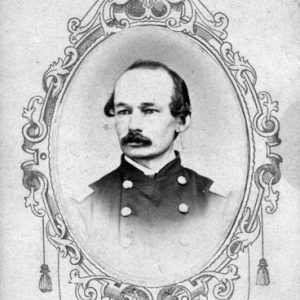calsfoundation@cals.org
Scouts from Lewisburg (August 11–14, 1864)
The scouts by troops from the Third Arkansas Cavalry Regiment (US) from Lewisburg (Conway County) were sent out in search of Confederate troops and guerrillas as General Joseph O. Shelby’s men operated in north-central and eastern Arkansas in the late summer of 1864.
Shelby’s troops had been operating north of the Arkansas River and between the White and Mississippi rivers since May 1864, forcing irregular troops into service with established regiments, conscripting every male aged fifteen to fifty into Confederate service, sinking the USS Queen City in Clarendon (Monroe County), and skirmishing with U.S. soldiers throughout the region. In early August, Shelby sent Colonel Archibald Dobbins to attack federally leased farms in Phillips County while Colonel Thomas McCray gathered recruits in the vicinity of Augusta (Woodruff County).
As Brigadier General Joseph R. West led a Union force to disrupt McCray’s activities, Brigadier General Eugene A. Carr ordered Colonel Abraham Ryan on August 11, 1864, “to keep your scouts out well toward the east and northeast” when detachments of the Third Arkansas were sent out in support of West.
Ryan reported on August 12 that Lieutenant Colonel Irving W. Fuller had just returned to Lewisburg after a scout to Clinton (Van Buren County), Kinderhook (modern-day Edgemont in Cleburne County), Richwoods (Stone County), and Wiley’s Cove (modern-day Leslie in Searcy County). Fuller reported “country swept of everything; all the men from fifteen to fifty gone to Shelby,” and said that Confederate colonels Thomas Freeman and John T. Coffee were at Batesville (Independence County) with 2,500 troops, while he found no sign of West. Fuller’s Third Arkansas troopers captured twelve Confederates and killed one during the scout.
A day later, Ryan reported that a scout under Captain Anthony Hinkle had sent ten prisoners captured by his scouts at Quitman (Cleburne and Faulkner counties) to Lewisburg, including a man who claimed to be a brother of Confederate Colonel A. R. Witt. Hinkle also sent word that McCray was falling back under Union pressure and that Shelby was reportedly heading down the White River.
Captain Thomas Boles and his scouting expedition from Company H of the Third Arkansas returned to Lewisburg on the evening of August 13 after reconnoitering in Dardanelle (Yell County), Danville (Yell County), and Bluffton (Yell County). Boles reported that his troops had fought two skirmishes in which two of his men were wounded, though they killed three men—including guerrilla Captain Blansel, who rode with the band of a man named Scott—while wounding four men and capturing three prisoners. The Federals reported “no enemy in Perry and Yell Counties except bushwhackers.”
Captain Hinkle and his troopers returned to base on August 16 with five more prisoners, reporting that “McCray’s army [is] melting away, and his men appearing in the country in small squads and depredating” and that West’s expedition was above the Little Red River and heading to Batesville. Ryan also reported on August 16 that small groups of rebels were crossing the White River at Myrick’s Mill while others were heading toward the Arkansas River along Cadron Creek and that Lieutenant Marvin Gates had returned from a five-day scout into Perry County with a party of dismounted Third Arkansas troopers with “nothing new” to report.
Despite these and other Union efforts to hinder his efforts, Shelby eluded Federal troops and, on August 24, led his men, including McCray’s command, in combat along the Memphis and Little Rock Railroad line west of DeValls Bluff (Prairie County), winning a substantial victory at Ashley’s Station before joining Major General Sterling Price on his doomed raid into Missouri.
For additional information:
Christ, Mark K. “‘The Queen City was a helpless wreck’: J.O. Shelby’s Summer of ’64.” In “The Earth Reeled and Trees Trembled”: Civil War Arkansas, 1863–64, edited by Mark K. Christ. Little Rock: Old State House Museum, 2007.
Hewett, Janet B., et al., eds. Supplement to the Official Records of the Union and Confederate Armies, Vol. 2. Wilmington, NC: Broadfoot Publishing Co., 1994, p. 93.
The War of the Rebellion: A Compilation of the Official Records of the Union and Confederate Armies, Series I, Vol. 41, part 1, pp. 235–236; part 2, pp. 652, 665, 685–686, 729. Washington DC: Government Printing Office, 1891.
Mark K. Christ
Central Arkansas Library System
 Civil War Timeline
Civil War Timeline Military
Military Abraham Ryan
Abraham Ryan 




Comments
No comments on this entry yet.